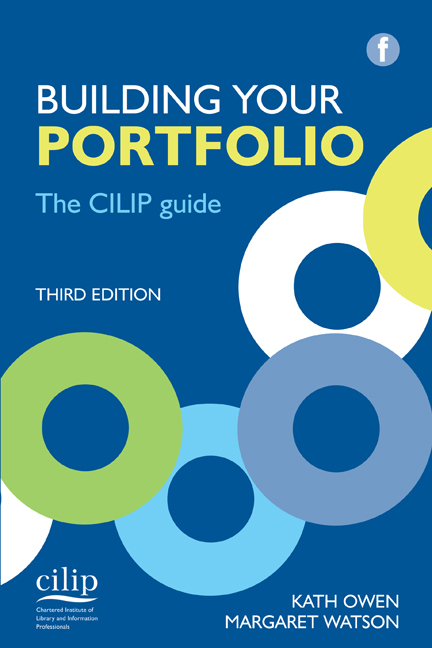Book contents
- Frontmatter
- Contents
- Contributors
- Foreword
- Acknowledgements
- 1 Introduction and getting started
- 2 Assessment criteria
- 3 Working with a mentor
- 4 Reflective writing
- 5 The curriculum vitae
- 6 The Professional Knowledge and Skills Base
- 7 Evaluative statements
- 8 Supporting evidence
- 9 The final steps
- Bibliography and references
- Websites
- Index
1 - Introduction and getting started
Published online by Cambridge University Press: 08 June 2018
- Frontmatter
- Contents
- Contributors
- Foreword
- Acknowledgements
- 1 Introduction and getting started
- 2 Assessment criteria
- 3 Working with a mentor
- 4 Reflective writing
- 5 The curriculum vitae
- 6 The Professional Knowledge and Skills Base
- 7 Evaluative statements
- 8 Supporting evidence
- 9 The final steps
- Bibliography and references
- Websites
- Index
Summary
The purpose of the book
The Chartered Institute of Library and Information Professionals (CILIP) introduced a professional registration scheme in December 2013. There are four elements in the scheme: Certification, Chartered Membership, Fellowship and Revalidation for Chartered Members and Fellows. The assessment of each level is by submission of an electronic Portfolio. This book has been written to support any Member of CILIP who wishes to apply for professional registration. This third edition reflects the introduction of professional registration and contains some personal contributions. For many of us working in the library and information profession the production of a Portfolio is a new experience and there has been much discussion about the nature of the Portfolio. This book is designed to answer some of those questions, sharing the experience, hints and tips of putting a Portfolio together from colleagues who have successfully achieved professional registration. Some of the contributors have completed their Portfolios very recently using the current regulations, others worked to the old regulations and, as the content requirements are so similar, their experiences are still relevant and a useful source of help for new candidates.
Each chapter deals with a specific aspect of the Portfolio, giving examples from each level as appropriate. The book can be either read straight through by potential candidates or used with greater discretion by applicants who may be having difficulties with particular elements of the Portfolio.
In the Foreword, Keith Wilson provides an overview of how Portfolios can be used in all aspects of a career and how important reflection is for the information professional.
This first chapter is an introductory chapter, looking at the purpose of the book and briefly outlining CILIP's Framework of Qualifications.
It discusses the process of getting started and the support available to Members as they put together their Portfolios, especially the CILIP Mentor Scheme. There are two very important aspects to the Framework: all Portfolios must meet specified assessment criteria, and applicants must demonstrate an appropriate level of reflective writing within their Portfolios. Chapter 2 discusses the assessment criteria and attempts to show how applicants can build their Portfolio to ensure that it meets those criteria; in a case study Keith Wilson, a previous Chair of the Chartership Board, gives his views on assessment.
- Type
- Chapter
- Information
- Building Your PortfolioThe CILIP guide, pp. 1 - 6Publisher: FacetPrint publication year: 2015



